A Guide To Concrete Resurfacing
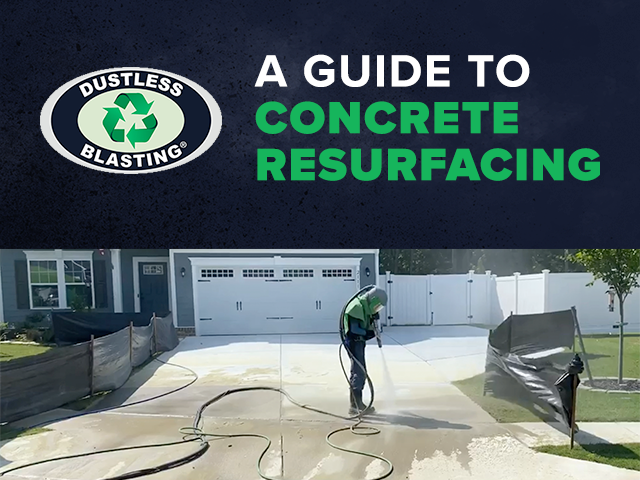
Concrete resurfacing is a process of restoring the appearance and durability of an existing concrete slab. Whether it's a patio, driveway, or a garage floor, concrete resurfacing can make a significant difference in the overall look and functionality of the space. In this guide, we will cover everything you need to know about concrete resurfacing, including the equipment options available, with a particular focus on Dustless Blasting.
Why Resurface Concrete?
Concrete surfaces, while sturdy and durable, can wear out over time due to heavy foot traffic, weather elements, and regular wear and tear. Resurfacing concrete is an ideal solution for restoring the look and functionality of a variety of surfaces. The process involves removing the top coating, such as failing paint, or even removing the first layer of the concrete surface and applying a new concrete coating or concrete-like material, such as an epoxy coating. By doing so, you can cover up any imperfections, stains, or cracks on the surface, giving it a fresh and modern look.
HOW TO RESURFACE CONCRETE
The majority of concrete surfaces require a similar process. Below are the steps you need to take for resurfacing concrete:
Prepare the Existing Concrete
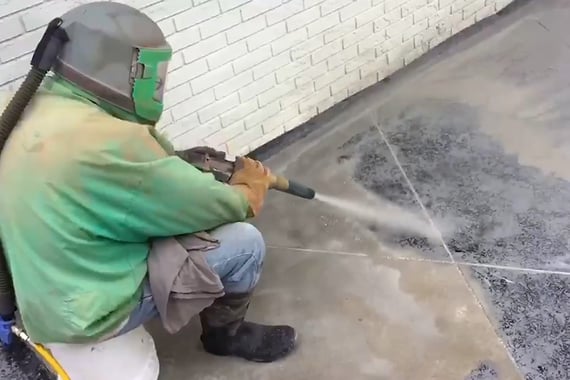
Before beginning the resurfacing process, it's crucial to ensure that the existing slab is clean, sound, and free of any failing coatings, debris or loose material. Surface preparation is the most critical step in successfully resurfacing concrete. You'll want to use an abrasive blasting system or pressure washer to remove any deteriorated concrete and to open up pours, which will help create a strong bond with the resurfacer. A Dustless Blasting system will also remove paint and sealers from an existing surface to make the prep work easier.
Repair The Cracked Concrete
Any cracks or damaged areas should be repaired with a suitable patching compound. While the concrete is wet, fill in any divots and smooth with a finish trowel.
Apply The Concrete Resurfacer
Start by generously dousing the area with water, making sure to remove any lingering puddles. Next comes the fun part - pouring the concrete overlay and using a long handled squeegee to expertly spread it across one-foot wide strips of concrete. Don't worry if you encounter tough spots - just apply extra pressure to work the material into the surface. When you reach tricky corners and edges, simply switch over to a trusty masonry brush. Remember, while it's important to put in the elbow grease, don't overwork the concrete resurfacer.
Five minutes after applying the concrete resurfacer, pull a concrete broom across the restored concrete perpendicular to traffic to provide a textured, non-skid surface.
How To Remove Paint From Concrete
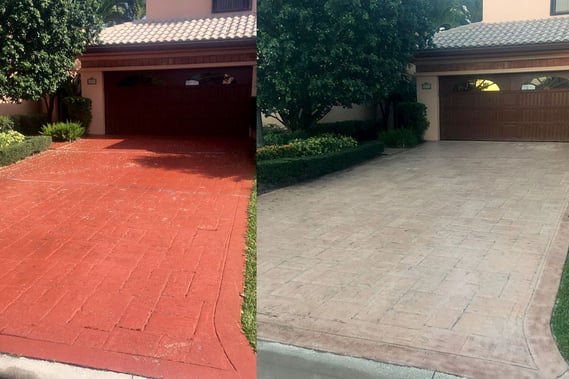
Removing failing paint from concrete can be a challenging and time-consuming process, but it's crucial to ensure the new layer of paint adheres correctly and looks good. One of the most effective methods for removing paint from concrete is by using a concrete grinder or media blaster. Both methods involve using abrasive media to grind down the existing paint layer, exposing the bare concrete surface. However, media blasters are typically more efficient and faster than grinders, making them a popular choice for larger-scale projects. Once the paint has been removed, the surface should be thoroughly cleaned and prepped before applying a new layer of paint or coating. It's important to note that failing paint on concrete may be a sign of other underlying issues, such as moisture or surface contamination, so it's essential to identify and address these issues before applying a new layer of paint. For more on how to remove paint from concrete with different methods, view this blog.
Concrete Etching
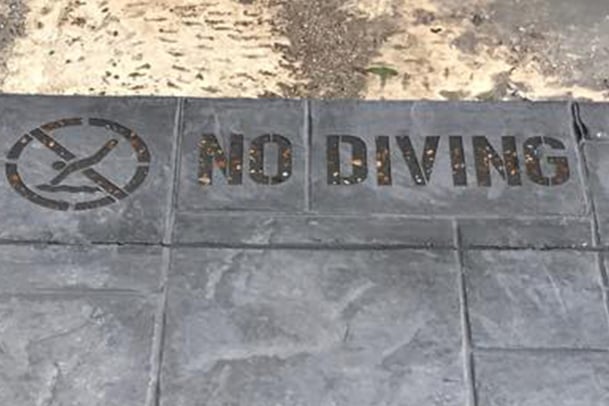
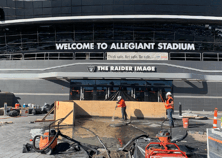
Concrete etching is a cleaning process that opens the pores of the concrete to prepare the surface for the next treatment. This allows the coating to better penetrate and adhere to the surface, providing a better, longer lasting finish. It can also be used to create decorative patterns or designs on new concrete surfaces. Etching can be done manually using specialized tools, or even with the help of Dustless Blasting equipment. Learn how to etch concrete in this blog article.
Concrete Resurfacing Projects
Most of the surfaces below require the same resurfacing process that we discussed previously. Take a look at different
Patios and Pool Decks
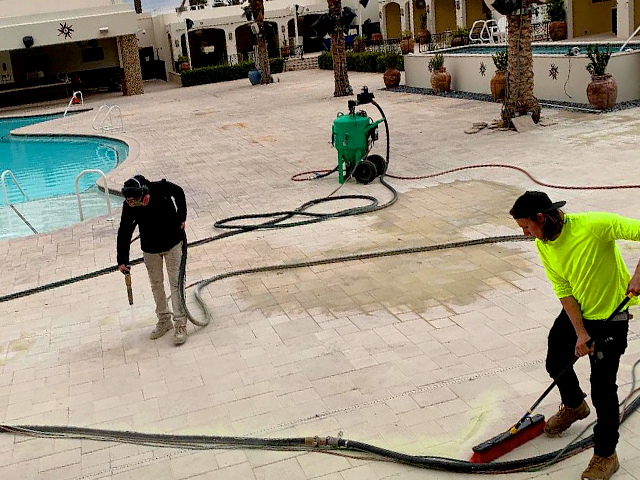
Pool deck resurfacing is essential to maintain the safety, functionality, and overall appearance of the pool area. Over time, pool decks can become damaged due to weather, pool chemicals, foot traffic, and other factors, leading to cracks, stains, and a worn-out look. Resurfacing the pool deck is an effective way to repair and restore the surface, creating a safe and attractive space for swimming and relaxing.
Various resurfacing options are available, such as concrete overlays, stamped concrete, and spray decking. The choice of resurfacing material will depend on the desired look, durability, and budget. Most pool owners go with a non slip finish for safety reasons.
Driveways
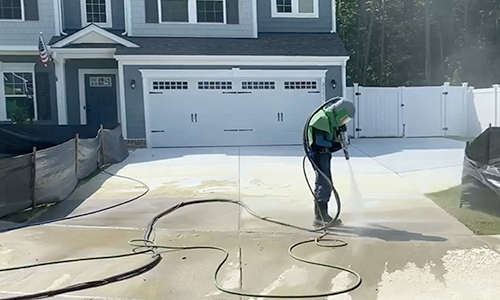
Over time, driveways can become cracked, stained, or faded, reducing their functionality. This project involves applying a new layer of material over the existing surface, creating a smooth, durable, and attractive finish. The material can be concrete, asphalt, or another material, depending on the desired look, texture and budget.
Parking Lots and Garages
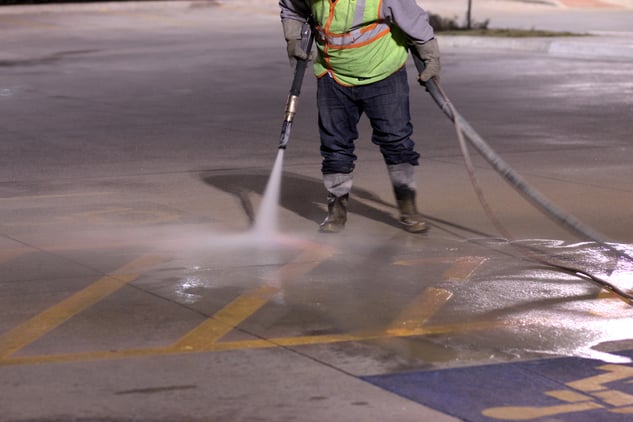
A Parking garage resurfacing project involves applying a new layer of material over the existing surface, creating a smooth, durable, and slip-resistant finish. The resurfacing material can be concrete, asphalt, or another material, depending on the desired look and budget. Before beginning the resurfacing process, any cracks, potholes, or other damage should be repaired, and the surface should be thoroughly cleaned. To learn how to remove paint and line stripes from parking lots or garages, view this blog post.
How Much Does Concrete Resurfacing Cost?
It will always be more cost effective to resurface concrete rather than to rip up and pour a new slab. Below are price ranges for how much certain projects cost depending on their type.
-
Patio: The average cost of a concrete patio will range anywhere from $3-$7 per square foot for a plain overlay. If you're interested in a stamped overlay, the cost will increase.
-
Garage Floor: Resurfacing a concrete garage floor with an epoxy coating costs $3-$7 per square foot.
-
Driveway: Concrete Driveway resurfacing costs $3-$5 per square foot for an average two-car driveway.
-
Pool Deck: Pool deck resurfacing can cost anywhere from $3 to $12 per square foot depending on the design.
Concrete resurfacing can cost as little as $3 per square foot or as much a $25 per square foot. Below are several factors that will determine the cost of your concrete resurfacing project.
The Condition of Your Existing Concrete
If your concrete is in good condition, it’s going to cost less than a concrete surface that has a lot of small cracks and chipping since damage must be repaired before applying a decorative coating.
Resurfacing concrete will always cost less than if you were to replace the entire surface.
The Project Size
The concrete slab is the foundation of your project and its size dictates the entire process - from the intense workload to the materials required, culminating in the final price.
Design
There are many concrete coatings and design options available for clients these days. The color, pattern and texture you choose to go with will impact the overall cost. A basic design is going to cost anywhere from $3-$7 per square foot whereas a complex design will cost $6-$20.
Concrete Resurfacing Products and Equipment
Several equipment and repair options are available for cleaning and stripping concrete, each with its unique advantages and disadvantages. Here are some of the most popular ones:
-
Concrete Grinders: Concrete grinders are used to grind down the existing concrete surface to create a rough surface that the new layer can adhere to. They come in different sizes and types, including handheld models and larger walk-behind machines.
- Pressure Washers: Removing paint and cleaning concrete is achievable with a pressure washer, but for this purpose, you will want to choose one with a pressure rating of at least 3000 psi. Usually this will take much longer than the other methods.
-
Shot Blasters: Shot blasters are machines that use high-pressure air to blast small metal balls at the concrete surface, removing any existing coating, paint, or dirt. They are ideal for large-scale projects and are more efficient than grinders.
-
Dustless Blasting Equipment: Dustless Blasting equipment is an abrasive blasting system that is recommended for resurfacing a variety of concrete surfaces. It uses water and abrasive media, such as recycled glass or garnet, to strip away the old surface. The process is more environmentally friendly and less dusty than traditional sandblasting.
Learn the difference between concrete grinders and abrasive blasters in this article.
Dustless Blasting: The Must-Have Concrete Restoration Tool
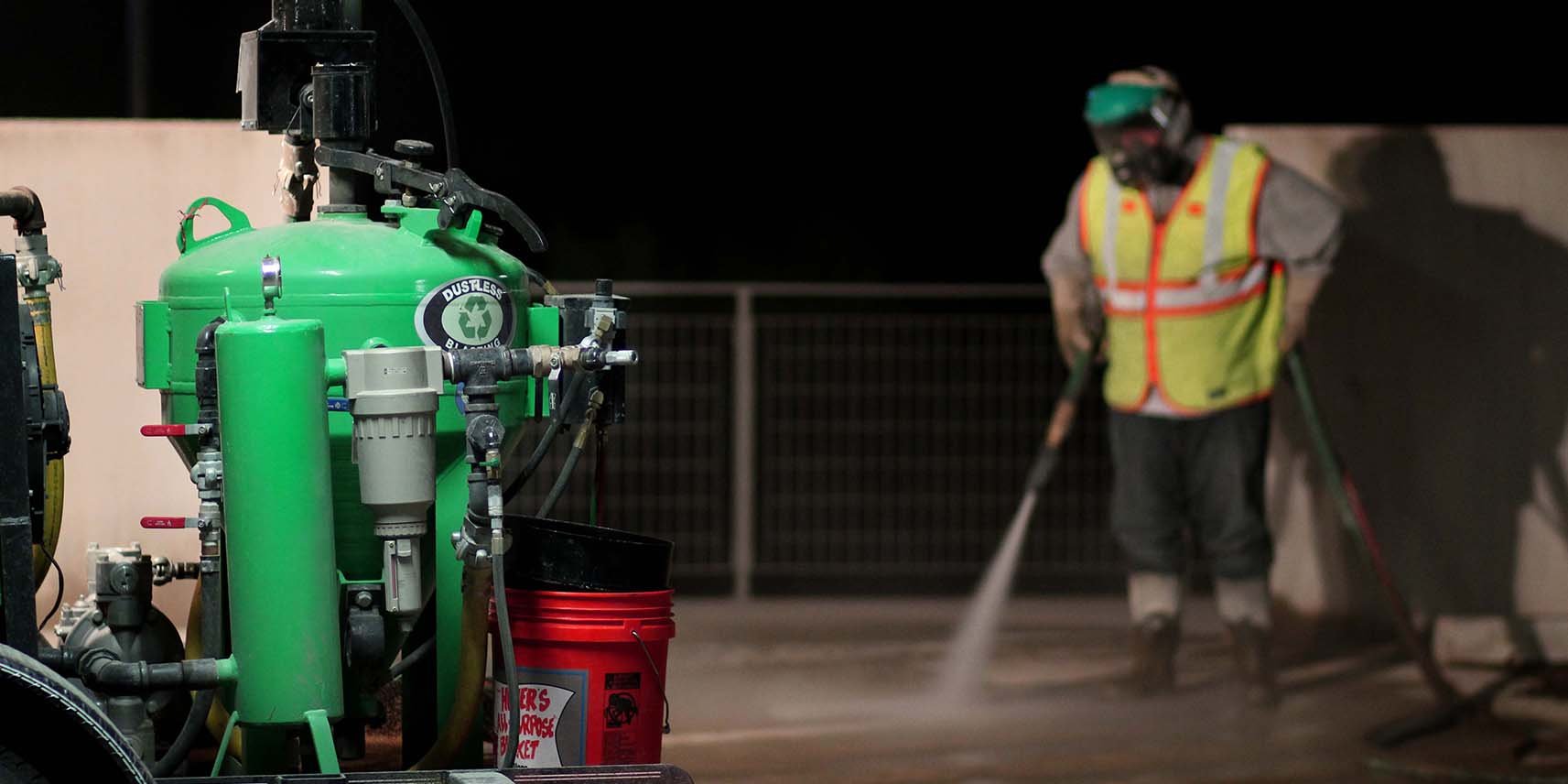
Dustless blasting is an ideal option for concrete surface preparation, especially when dealing with large-scale projects. The equipment is designed to mix water and abrasive media before blasting the surface, creating a wet slurry that eliminates dust and debris. Operators can easily remove paint, epoxy, sealers, stains and grime from a variety of concrete surfaces.
In addition to being more efficient and less dusty, Dustless Blasting is also more environmentally friendly than traditional sandblasting. The process uses recycled glass or garnet as the abrasive media, which reduces waste and prevents harm to the environment. The ability to blast wet is much safer for the operator since concrete surfaces contain silica sand. Suppressing dust is very important for worker safety when blasting concrete substrates. The wet slurry produced during the process can be easily collected and disposed of without any harm to the environment. This makes Dustless Blasting equipment more suitable for residential projects like pool deck restoration, driveway repair, concrete patio jobs and curb refinishing projects.
For more information on restoring concrete with Dustless Blasting, view this applications page or download our free case study!
